中国农业大学讲义食品学院食品工艺学课件411
- 格式:ppt
- 大小:2.04 MB
- 文档页数:23
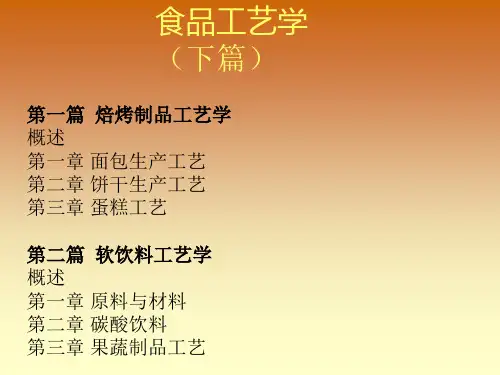
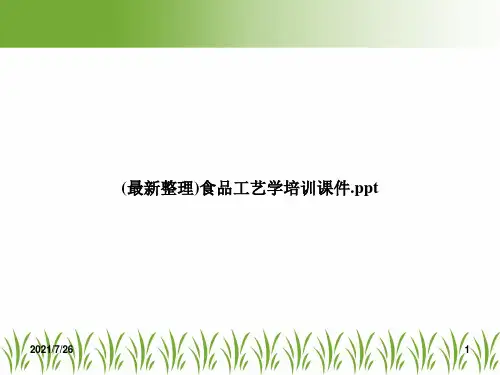

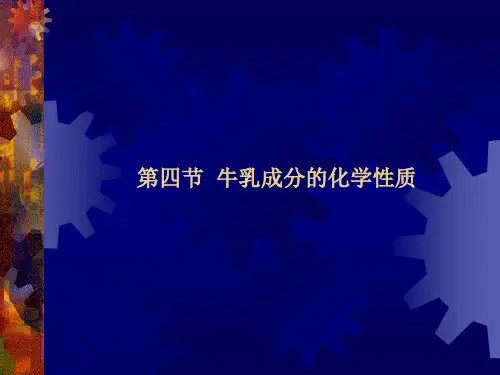
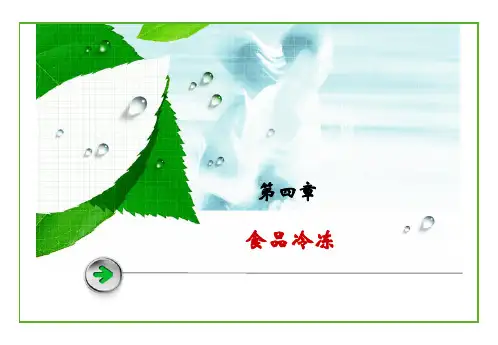
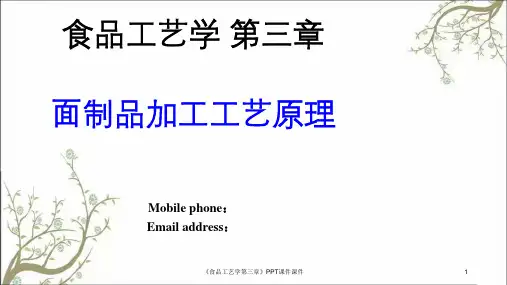
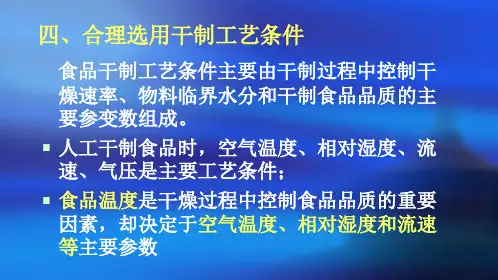

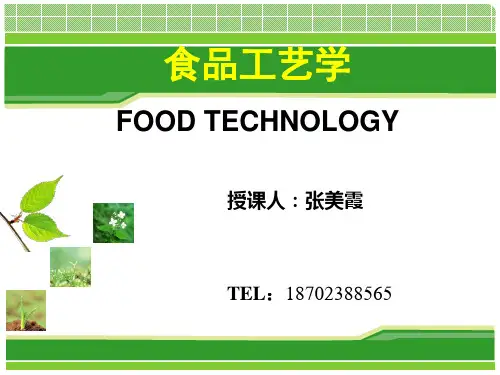
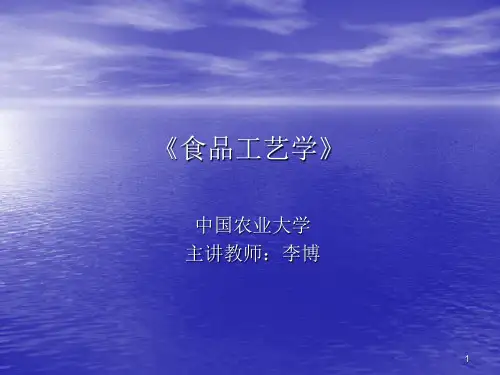
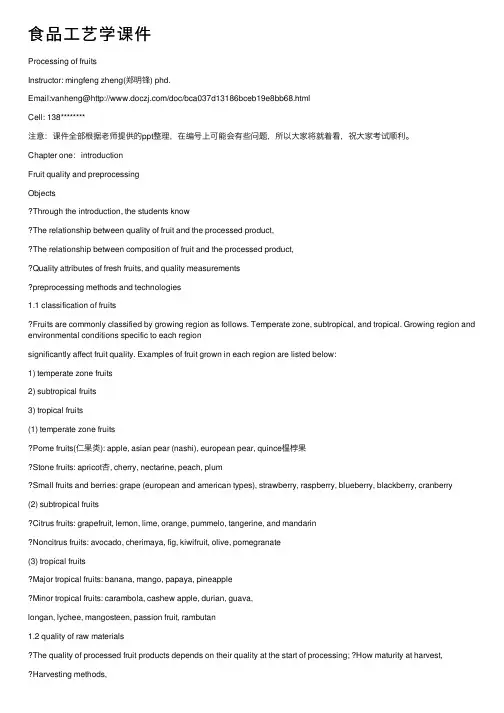
⾷品⼯艺学课件Processing of fruitsInstructor: mingfeng zheng(郑明锋) phd.Email:vanheng@/doc/bca037d13186bceb19e8bb68.htmlCell: 138********注意:课件全部根据⽼师提供的ppt整理,在编号上可能会有些问题,所以⼤家将就着看,祝⼤家考试顺利。
Chapter one:introductionFruit quality and preprocessingObjectsThrough the introduction, the students knowThe relationship between quality of fruit and the processed product,The relationship between composition of fruit and the processed product,Quality attributes of fresh fruits, and quality measurementspreprocessing methods and technologies1.1 classification of fruitsFruits are commonly classified by growing region as follows. Temperate zone, subtropical, and tropical. Growing region and environmental conditions specific to each regionsignificantly affect fruit quality. Examples of fruit grown in each region are listed below:1) temperate zone fruits2) subtropical fruits3) tropical fruits(1) temperate zone fruitsPome fruits(仁果类): apple, asian pear (nashi), european pear, quince榅桲果Stone fruits: apricot杏, cherry, nectarine, peach, plumSmall fruits and berries: grape (european and american types), strawberry, raspberry, blueberry, blackberry, cranberry (2) subtropical fruitsCitrus fruits: grapefruit, lemon, lime, orange, pummelo, tangerine, and mandarinNoncitrus fruits: avocado, cherimaya, fig, kiwifruit, olive, pomegranate(3) tropical fruitsMajor tropical fruits: banana, mango, papaya, pineappleMinor tropical fruits: carambola, cashew apple, durian, guava,longan, lychee, mangosteen, passion fruit, rambutan1.2 quality of raw materialsThe quality of processed fruit products depends on their quality at the start of processing; How maturity at harvest, Harvesting methods,Post harvest handling proceduresMaintenance in fresh fruits between harvest and process initiation.Quality attributes of fresh fruitsAppearance、exture factors、flavor components、nutritional quality、safety factorsAppearance factorsSize、shape、color、freedom from defects and decay.Texture factorsFirmness, crispness, juiciness.Flavor componentsSweetness, sourness (acidity), astringency, (收敛),bitterness, aroma, off-flavors,Nutritional qualityFruit's content of vitamins (a and c are the most important in fruits), minerals, dietary fiber, carbohydrates, proteins. Safety factorsResidues of pesticides, presence of heavy metals, mycotoxins produced by certain species of fungi, microbial contamination.1.3 losses in fresh fruits after harvastWater loss,Physical injuries,physiological breakdown, decayLoss of acidity, flavor, color, and nutritive valueFactors influence fruit qualityIn the orchard,During transportation,Throughout the handling system (sorting, sizing, ripening, and storage).The total time between harvesting and processingMinimizing the delays throughout the post harvest handling system greatly reduces finality loss, especially in highly perishable fruits such as strawberries, blackberries, apricots, and cherries.1.4 contribution of fruits to human nutritionEnergy (calories)VitaminsMineralsDietary fiberThe us. Department of agriculture and other organizations currently encourage consumers to participate in the "five a day" program which focuses on consumption of five servings of either fruit or vegetables each day.Energy (calories)(1) carbohydrates: banana, breadfruit, raisin葡萄⼲(2) proteins & amino acids: nuts, dried apricot and fig(3) fats. Avocado, olive, nutsFruits typically contain between 10% and 25% carbohydrates, a small amount (less than1.0%) of proteins, and a very small amount (less than 0.5 %) of fat. Carbohydrates, sugars,and starches are broken down to co2, water, and energy during metabolism. Carbohydrates and fats provide most of the calories the body requires for heat and energy.Vitamins(1) fresh fruits and vegetables contribute about 91% of vitamin c, 48% of vitamin a, 27% of vitamin b6, 17% of thiamin硫胺(维⽣素b1) to diet.(2) the following fruits are important contributors (based on their vitamin content and the amount consumed) to the supply of indicated vitamins in the u.s. Diet:*vitamin a: apricot, peach, cherry, orange, watermelon, cantaloupe*vitamin c: strawberry, orange, grapefruit, banana, apple, cantaloupe* niacin烟酸: peach, banana, orange, apricot"*riboflavin核黄素: banana, peach, orange, apple* thiamin: orange, banana, grapefruit, appleMinerals(1) fresh fruits and vegetables contribute about 26% of the magnesium镁and 19% of the iron to the u.s. Diet.(2) the following fruits are important contributors to the supply of indicated minerals in the us. Diet:* potassium钾: banana, peach, orange, apple* phosphorus磷: banana, orange, peach, raisin, fig*calcium: tangerine, grapefruit, orange* iron: strawberry, banana, apple, orangeDietary fiber(1) all fruits and nuts contribute to the dietary fiber in the diet. Dietary fiber consists of cellulose, hemicellulose, lignin⽊质素, and pectic substances, which are derived primarily from fruit cell walls and skin.(2) the dietary fiber content of fruits ranges from 0.5-1.5% (fresh weight basis).(3) dietary fiber plays an important role in relieving constipation by increasing water-holding capacity of feces. Its consumption is also linked to decreased incidence of cardiovascular disease, diverticulosis, and colon cancer.factors influefncing composition and quality of fruitsPreharvest factors(1) genetic: selection of cultivars, differences in raw fruit composition, durability, and response to processing. Fruit cultivars grown for fresh market sale will not be the optimal cultivars for processing.(2) climatic: temperature, light, wind--climatic factors may have a strong influence on nutritional quality of fruits. Light intensity significantly affects vitamin concentration, and temperature influences transpiration rate, which will affect mineral uptake and metabolism. ?(3) cultural practices: soil type, soil nutrient and water supply, pruning修剪, thinning, pest control-fertilizer addition may significantly affect the mineral content of fruit.1. 5 maturity at harvest and harvesting methodMaturity at harvest is one of the primary factors affecting fruit composition, quality, and storage life. Although most fruits reach peak eating quality when harvested fully ripe, they are usually picked mature, but not ripe, to decrease mechanical damage during postharvest handling. Harvesting may also mechanically damage fruit; therefore, choice of harvest methodshould allow for maintenance of quality.Postharvest factors1) environmental,2) handling methods,3) time period between harvesting and consumption(1) environmentalTemperature, relative humidity, atmospheric composition,(2) handling methodsPostharvest handling systems involve the channels through which harvested fruit reaches the processing facility or consumer. Handling methods should be chosen such that they maintain fruit quality and avoid delays.(3) time period between harvesting and consumptionDelays between harvesting and cooling or processing may result in direct losses (due to water loss and decay) and indirect losses (decrease in flavor and nutritional quality).Fruit maturity, ripening, and quality relationshipsMaturity at harvest is the most important factor that determines storage life and final fruit quality. Immature fruits are of inferior quality when ripened. Overripe fruits are likely to become soft and with insipid flavor soon after harvest. Fruits picked either too early or too late in the season are more susceptible to physiological disorders and have a shorter storage life than those picked at mid-season.Maturity and ripeningIn general, fruits become sweeter, more colorful, and softer as they mature.Some fruits are usually picked mature but unripe so that they can withstand the postharvest handling system when shipped long distances. Most currently used maturity indices are based on a compromise between those indices that would ensure the best eating quality to the consumer and those that provide the needed flexibility in transportation and marketing.Carbohydrates(碳⽔化合物)Carbohydrates : fresh fruits vary greatly in their carbohydrate content, with a general range being between 10% and 25%;. The texture, taste, and food value of a fresh fruit is related to its carbohydrate content. Sucrose, glucose, and fructose are the primary sugars found in fruits.Fructose is sweeter than sucrose, and sucrose is sweeter than glucose.Starch is converted to sugar as the fruits mature and ripen.Proteins(蛋⽩质)Fruits contain less than 1% protein (as opposed to 9-20% protein in nuts such as almond, and walnut). Changes in the level and activity of proteins resulting from permeability changes in cell membranes may be involved in chilling injury. Enzymes, which catalyze metabolic processes in fruits, are proteins that are important in the reactions involved in fruit ripening and senescence.Enzymes in fruits:(Organic acids(有机酸)Organic acids are important intermediate products of metabolism. The krebs (tca) cycle is the main channel for the oxidation of organic acids in living cells, and it provides the energy required for maintenance of cell integrity. Organic acids aremetabolized into manyconstituents, including amino acids, which are the building blocks of proteins.Citric acid、malic acid、tartaric acid、oxalic acidPigments(⾊素)Pigments undergo many changes during the maturation and ripening of fruits.(1) loss of chlorophyll (green color), which is influenced by ph changes, oxidative conditions, and chlorophyllase action(2) synthesis and/or revelation of carotenoids (yellow and orange colors)(3) development of anthocyanins (red, blue, and purple colors.Beta-carotene is a precursor to vitamin a. Carotenoids are very stable and remain intact in fruit tissues, even when extensive senescence has occurred.Phenolic compounds(酚类化合物)Total phenolic content is higher in immature fruits than in mature fruits and is the main substrate involved in enzymatic browning of cut, or otherwise damaged, fruit tissues when exposed to air.Enzymatic browning(酶促褐变)Enzymatic browning occurs due to the oxidation of phenolic compounds and is mediated, in the presence of o2, by the enzyme polyphenoloxidase (ppo). The initial product of oxidation is usually o-quinone, which is highly unstable and undergoes polymerization to yield brown pigments of higher molecular weight. Polyphenoloxidase catalyzes the following tworeactions:Volatiles(挥发性)Volatiles are responsible for the characteristic aroma of fruits. They are present in extremely small quantities (c <100µg/g fresh wt.).Volatile compounds are largely esters(酯), alcohols, acids, aldehydes(醛), an d ketones (low-molecular weight compounds).VitaminsThe water-soluble vitamins includeVitamin c,Thiamin硫胺(维⽣素b1),Riboflavin核黄素,Niacin烟酸, vitamin b6,Folacin叶酸, vitamin b12, biotin维⽣素h. Fat soluble vitamins include vitamins a, d, e, and k.Fat-soluble vitamins are less susceptible to postharvest losses.Vitamin cAscorbic acid is most sensitive to destruction when the commodity is subjected to adverse handling and storage conditions. Losses are enhanced by extended storage, highertemperatures, low relative humidity, physical damage, and chilling injury. Postharvest losses in vitamins a and b are usually much smaller than losses in vitamin c.1.7 biological factors involved in postharvest deterioration (变坏) of fruits ?Respiration (呼吸作⽤)Ethylene productionTranspiration (蒸腾作⽤)Physiological disordersPhysical damagePathological breakdownRespirationStored organic materials (carbohydrates, proteins, fats) are broken down into simple end products with a release of energy. Oxygen (o2) is used in this process, and carbon dioxide (co2) is produced.The loss of stored food reserves in the commodity during respiration hastens senescence as the reserves that provide energy to maintain the commodity's living status are exhausted. ?Food value (energy value) for the consumer is lost; it has reduced flavor quality, with sweetness especially being lost; and salable dry weight is lost (especially important for commodities destined for dehydration). The energy released as heat.Ethylene productionEthylene, the simplest of the organic compounds affecting the physiological processes of plants, is produced by all tissues of higher plants. As a plant hormone, ethylene regulates many aspects of growth development, and senescence and is physiologically active in traceamounts (less than 0.1 ppm).Transpiration or water lossWater loss is the main cause of deterioration because it results not only direct quantitative.Losses (loss of salable weight) hut also in loss of its appearance, loss of cripsness, andjuiciness), and nutritional quality.The dermal system (outer protective coverings) governs the regulation of water loss by the commodity.Physiological disorders(1) freezing injury :usually results in immediate collapse of the tissues and total loss.(2) chilling injury when fruits (mainly those of tropical and subtropical origin) are held at temperatures above their freezing point and below 5-15℃, depending on the commodity. ?(3) heat injury results from exposure to direct sunlight or to excessively high temperatures.Symptoms include surface scalding, uneven ripening, excessive softening, and desiccation. ?(4) very low (<1%) oxygen and/or elevated (>20%) carbon dioxide concentration can result in physiological breakdown of all fruits.Physical damageVarious types of physical damage (surface injuries, impact bruising, vibration bruising, etc.) Are major contributors to deterioration. Mechanical injuries are not only unsightly, but also accelerate water loss, stimulate higher respiration and ethylene production rates, and favor decay incidence.Pathological breakdownDecay is one of the most common or apparent causes of deterioration; however, attack by many microorganisms usually follows mechanical injury or physiological breakdown, which allows entry to the microorganism. Pathogens can infect healthy tissues and become the primary cause of deterioration.Environmental factors influencing deterioration of fruits(影响⽔果变坏的环境因素)Temperature,Relative humidity,Air movement,Atmospheric composition,Ethylene,Harvesting procedures Postharvest handling proceduresDumping、Sorting、Sizing、Cooling、Storage、RipeningDumping:Fresh fruits should be handled with care throughout the postharvest handling system in order to minimize mechanical injuries. Dumping in water or in flotation tanks should be used for fruits. If dry dumping systems are used, they should be well padded bruising. Sorting:Manual sorting is usually carried out to eliminate fruit exhibiting defects or decay. For some fruits, it may also be necessary to sort the fruit into two or more classes of maturity or ripeness.Mechanical sorters, which operate on the basis of color, soluble solids, moisture, or fat content, are being implemented and may greatly reduce time and labor requirements. Sizing:In some cases, sizing the fruits into two or more size categories may be required before processing. Sizing can be done mechanically on the basis of fruit dimension or by weight.Mechanical sizing can be a major source of physical damage to the fruit if the machines are not adequately padded and adjusted to the minimum possible fruit drop heights Ripening:Ripening before processing may be required for certain fruits (banana, kiwifruit, mango, papaya, peach, pear, plum, melon) that are picked mature but unripe. Ethylene treatment can be used to obtain faster and more uniform ripening. The optimum temperature range for ripening is 15-25℃and, within this range, the higher the temperature, the faster the ripening. Relative humidity should be maintained between 90% and 95 % during ripening. Cooling:Cooling is utilized to remove field heat and lower the fresh fruit's temperature to near its optimum storage temperature. Cooling can be done using cold water (hydrocooling) or cold air (forced-air cooling or "pressure cooling"). Highly perishable fruits, such as strawberries, bush berries, and apricots, should be cooled to near 4℃within six hours of harvest. Other fruits should be cooled to their optimum temperature within twelve hours of harvest. Storage:Short-term or long-term storage of fresh fruits may be needed before processing to regulate the product flow and extend the processing season. The relative humidity in the storage facility should be kept between 90% and 95%.To reduce decay, elevated c02 (15-20%) may be added to the atmosphere within pallet covers for strawberries, bush berries, and cherries, and sulfur dioxide (200 ppm) fumigation may be used on grapes.1.8 quality measurementsMany quality measurements can be made before a fruit crop is picked in order to determine if proper maturity or degree of ripeness has developed.ColourColour may be measured with instruments or by comparing the colour of fruit on the tree with standard picture charts. TextureTexture may be measured by compression by hand or by simple type of plungers.Soluble solidsAs fruit mature on the tree its concentration of juice solids, which are mostly sugars, changes. The concentration of soluble solids in the juice can be estimated with arefractometer or a hydrometer液体⽐重计.Acid contentThe acid content of fruit changes with maturity and affects flavour. Acid concentration can be measured by a simple chemical titration on the fruit juice. But for many fruits the tartness and flavour are really affected by the ratio of sugar to acid. Sugar to acid ratioIn describing the taste of tartness of several fruits and fruit juices, the term "sugar to acid ratio" or "brix to acid ratio" are commonly used. The higher the brix the greater the sugar concentration in the juice; the higher the "brix to acid ratio" the sweeter and lees tart is the juice.1.9 preprocessing1.9.1 harvestingThe above and other measurements, plus experience, indicate when fruit is ready for harvesting and subsequent processing.1.9.2 reception - quality and quantity1.9.3 temporary storage before processing1.9.4 washingHarvested fruit is washed to remove soil, micro-organisms and pesticide residues.Fruit washing is a mandatory processing step; it would be wise to eliminate spoiled fruit before washing in order to avoid the pollution of washing tools and/or equipment and the contamination of fruit during washing.1.9.5 sortingFruit sorting covers two main separate processing operations:Removal of damaged fruit and any foreign bodies (which might have been left behind after washing);Qualitative sorting based on organoleptic criteria and maturity stage.Mechanical sorting for size is usually not done at the preliminary stage. The most important initial sorting is for variety and maturity.1.9.6 trimming and peeling (skin removal)This processing step aims at removing the parts of the fruit which are either not edible or difficult to digest especially the skin.Up to now the industrial peeling of fruit and vegetables was performed by three procedures: Mechanically;By using water steam;Chemically; this method consists in treating fruit and vegetables by dipping them in a caustic soda solution at a temperature of 90 to 100°c; the concentration of this solution as well asthe dipping or immersion time varying according to each specific case.1.9.7 cuttingThis step is performed according to the specific requirements of the fruit processing technology.1.9.8 blanchingA brief heat treatment to vegetables some fruits to inactivate oxidative enzyme systems such as catalase, peroxidase, polyphenoloxidase, ascorbic acid oxidase, and lipoxygenase. ?When the unblanched tissue is disrupted or bruised and exposed to air, these enzymes come in contact with substrates causing softening, discoloration, and the production of off flavors. ?It is most often standard practice to blanch fruits in order to prevent quality deterioration. ?Although the primary purpose of blanching is enzyme inactivation.There are several other benefits blanching initially cleanses the product;Decreases the microbial load,Preheats the product before processing.Softens the fruit, facilitates compact packing in the can.Expell intercellular gases in the raw fruitImproved heat transfer during heat processing.Water blanching is generally of the immersion type or spray type as the product moves on a conveyor.Steam blanching often involves belt or chain conveyors upon which the product moves through a tunnel containing live steam.adequacy of blanching is usually based on inactivation of one of the heat resistant enzymes (peroxidase or polyphenol oxidase).During the blanching process, it is imperative that certain enzymes that have the potential to cause flavour and textural changes be inactiviated. The process involves a brief heattreatment applied to most vegetables and also to some fruits in order to inactivate oxidative enzyme system such as catalase, peroxidase, polyphenoloxidase,ascorbic acid oxidase, and lipoxygenase.When unblanched tissue is disrupted or bruised and exposed to air,these enzymes come in contact with substrate causing softening,discoloration, and the production of off-flavours.Since this action can potentially occur during the period prior to heat processing, it is most often standard practice to blanch fruits in order to prevent quality deterioration.1.9.9 ascorbic/citric acid dipAscorbic acid or vitamin c minimises fruit oxidation primarily by acting as an antioxidant and itself becoming oxidised in preference to catechol⼉茶酚-tannin compounds.It has been found that increased acidity also helps retard oxidative colour changes and so ascorbic acid plus citric acid may be used together. Citric acid further reacts with (chelates) metal ions thus removing these catalysts of oxidation from the system.1.9.10 sulphur dioxide treatmentSulphur dioxide may function in several ways:Sulphur dioxide is an enzyme poison against common oxidising enzymes;It also has antioxidant properties; i.e., it is an oxygen acceptor (as is ascorbic acid);Further so2 minimises non enzymatic maillard type browning by reacting with aldehyde醛groups of sugars so that they are no longer free to combine with amino acids;Sulphur dioxide also interferes with microbial growth.In many fruit processing pre-treatments two factors must be considered:Sulphur dioxide must be given time to penetrate the fruit tissues;So2 must not be used in excess because it has a characteristic unpleasant taste and odour, and international food laws limit the so2 content of fruit products, especially of those which are consumer oriented (e.g. Except semi-processed products oriented to further industrial utilisation).5.2.11 sugar syrupSugar syrup addition is one of the oldest methods of minimising oxidation.Sugar syrup minimises oxidation by coating the fruit and thereby preventing contact withatmospheric oxygen.Sugar syrup also offers some protection against loss of volatile 挥发性的fruit esters 酯and itcontributes sweet taste to otherwise tart fruits.It is common today to dissolve ascorbic acid and citric acid in the sugar syrup for addedeffect or to include sugar syrup after an so 2 treatment.QuestionsWhat factors influence the quality of fruits after harvest?How to maintain the fruit in good quality before the processing begin?第⼀节果蔬原料特性新鲜果蔬原料的特点 ? 果蔬原料的化学成分原料的化学成分与加⼯的关系1.新鲜果蔬原料的特点易腐性、季节性、区域性2.果蔬中的化学成分(chemical composition in fruits and vegetables )3.化学成分与加⼯的关系(relation between chemical composition and processing )3.1 ⽔分(water)果蔬中⽔的含量:⼤多数在80%以上,含⽔量⾼的如冬⽠(wax gourd)可达96%以上。